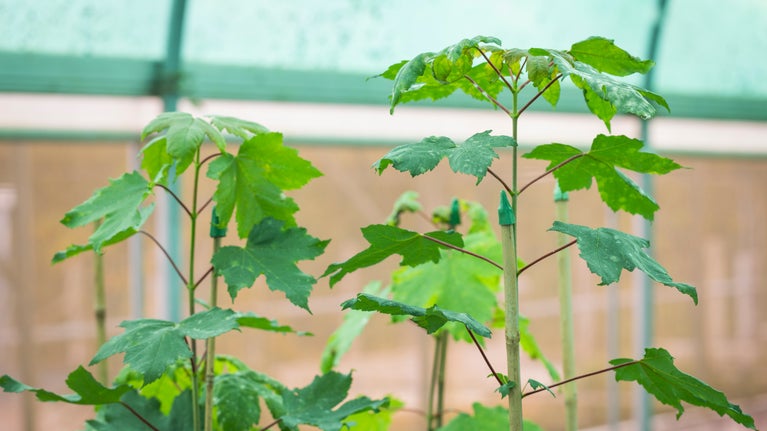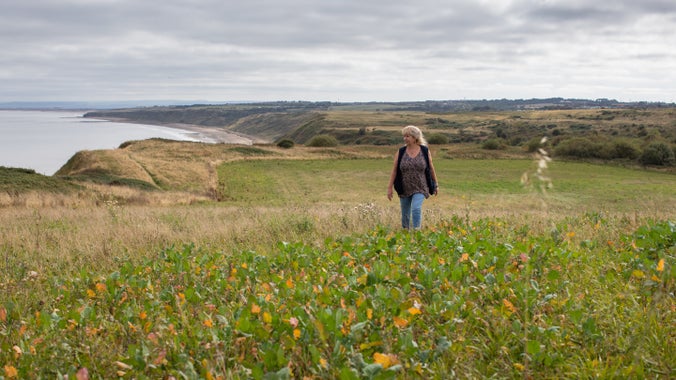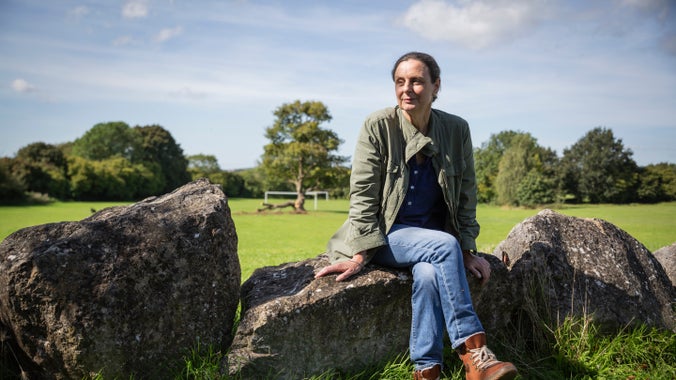Sycamore Gap Tree One Year On - 'Trees of Hope' case studies
- Published:
- 26 September 2024

The National Trust has this morning (Friday 27 September) announced more details to help inspire people and communities to apply for one of the 49[1] ‘Trees of Hope’ – grown from seed from the sycamore gap tree which formerly stood proudly in the gap, towering above Hadrian’s Wall in Northumberland National Park, until it was illegally felled, one year ago.
The ‘Trees of Hope’ initiative aims to ensure that the legacy of the iconic tree lives on for generations to come and can benefit people and communities all across the UK.
Hilary McGrady, Director General of the National Trust said: “The response to the illegal felling of the Sycamore Gap tree really shone a light on the importance of nature in our both our daily lives and as part of our cultural heritage as a nation.
“We’ve received so many stories and letters about people’s connections with the tree – from marriage proposals under its branches, to fond holiday memories, and poignant reminders of family and friends. So, it was really important to us that we’d made sure the tree had a lasting and positive legacy.
“Today we’re inviting people and communities all around the UK to apply for one of the new saplings grown from this much-loved sycamore. By doing this, we hope to share a remarkable piece of living history with many more people, and help bring more nature to towns and cities for generations to come.”
Nikki Crowley, who is leading the initiative for the National Trust added: “The thousands of messages from people who wanted to share just what the tree meant to them really did make it feel like the peoples’ tree and that helped us decide on the future of the saplings.
“The 49 ‘Trees of Hope’ will be gifted to individuals and communities to plant in publicly accessible spaces, with each tree telling a story of hope, wellbeing, culture, celebration, recovery or connection with nature.”
To help inspire people to apply, the conservation charity has revealed details of two places which will also receive a sapling once they are hardy enough to plant outside[3]. One in the north east, and one in south Bristol.
Tina’s Haven on the Durham coast is an area of National Trust land being restored for nature with the aim of enhancing recovery for both people and nature.
The charity’s ambition is that the land at Tina’s Haven will be developed with the communities of East Durham, one of the most economically deprived former mining areas in the region. The programme is named in memory of Tina Robson – a young woman who lost her life to addiction – and the aim is for Tina’s ‘Tree of Hope’ to form part of this community nature reserve.
The National Trust will also be planting over 20,000 trees at the site, a reflection of the charity’s ambitions to plant thousands more trees across the region, thanks in part to funds donated to the charity’s fundraising campaign after the sycamore gap tree was felled – but also nature conservation.
A second tree will also be planted in south Bristol – to celebrate the life of a young boy, Fergus who sadly died of bone cancer at just 12 years old, and as a symbol of hope and recognition for all those suffering from childhood cancers and the families affected.
For more information and to request a sapling, visit: www.nationaltrust.org.uk/TreesOfHope
The closing date for entries is 25 October 2024[2], with successful applicants to be announced towards the end of November, during National Tree Week.
To make a donation towards the National Trust’s tree planting ambitions or conservation work in the area, visit www.nationaltrust.org.uk/hadrians-wall-appeal
Case studies in detail:

‘Trees of Hope’ – Tina’s Haven
At Easington on the Durham Coast the National Trust and Tina’s Haven, an arts and nature-based programme that enhances women’s recovery from addiction and trauma, are working together to create a beautiful and natural space for reflection and recovery.
Named ‘Tina’s Haven’, the 34 hectares (84 acres) of coastal fields is set to become a landscape of rolling meadows, hedgerows, ponds and woodlands overlooking the North Sea to be a nature filled sanctuary and a space for community led activity.
A sapling grown from a seed from the felled sycamore gap tree (just 58 miles away) will be planted in the space to signify hope, recovery, healings and new beginnings.
The National Trust has spent the last 40 years cleaning up the beaches that neighbour the former coalfields close to Tina’s Haven.
By restoring the land, the aim is to help heal years of neglect to both nature and people and the green space will support women involved in the Tina’s Haven programme and to reach out and bring hope to others in some of the most deprived former mining areas of East Durham.
The Tina’s Haven programme[4] is arts and nature based, and was founded in east Durham by Dr Sue Robson, in memory of her daughter, Tina, who died in July 2020. At just 35 years old, Tina had struggled with drug and alcohol addiction for most of her adult life.
When she was 23 years old Tina had had a son, Vinnie, who remained in the guardianship of his maternal family when he was born to prevent him being adopted. Despite these difficult circumstances, their maternal bond remained strong, something many children and mothers like Vinnie and Tina wouldn’t have the same opportunity to experience.
Two years after Tina’s passing Sue began working with The Barn at Easington, Addictions North East and the Own My Life Course to develop a model holistic practice for birthmothers severed from their children, to enhance their recovery and healing from addiction, VAWG and trauma.
Dr Sue Robson, founder of Tina’s Haven programme said: “Some say that connection is the opposite of addiction. In Tina’s Haven, women find self-empowerment, solidarity with other women, increased well-being and a strong sense of spirituality from being immersed in nature; effectively connecting women’s recovery to the recovery of the land.
“The naming and development of Tina’s Haven by the National Trust as a natural space for reflection and recovery, positioned magnificently on the East Durham Coast will help us engage the communities who live and work here, spreading our message of hope across and beyond the addiction recovery community.
“The addition of one of the sycamore gap trees is a highly significant symbol of hope for East Durham. It symbolizes that even after being subject to the worst adversity and acts of violence, there can be recovery, healing, and new beginnings; and hope can grow in abundance.”

‘Trees of Hope’ – Fergus’s tree
Fergus was just 12 years old when he died from Osteosarcoma (bone cancer) in May 2022.
Fergus lived with his mum and dad in the village of Backwell, south of Bristol.
He loved the outdoors. He enjoyed playing in his local park and especially loved tennis and cricket. He was supposed to be going on his annual boys trip with his dad to walk Hadrian’s Wall in 2020 – but Covid-19 hit, and the trip was postponed, with plans to visit instead once restrictions were lifted and life went back to ‘normal’.
But for Fergus and his family, life was never to be the same again.
Fergus was diagnosed with bone cancer in January 2021. He courageously endured a series of unforgiving treatments for the disease for 10 months including surgery to replace his femur and knee with a metal prothesis.
Due to his immense spirit, determination and strength within just three weeks of his last treatment, he was playing wheelchair tennis and wheelchair rugby and adjusting to his new life. However, just a few months later he relapsed and just a few weeks later, Fergus died.
Two years on, his mum, Ruth, contacted the Trust after hearing about the saplings successfully growing from seeds rescued from the felled sycamore gap tree. Together with her husband she had been on the search for a suitable tree to plant in memory of their son. It seemed a fitting tribute as it was the trip planned, but never taken.
Ruth explained: “We wanted to plant a tree for Fergus in our local park, by the tennis courts in a place where he spent hours enjoying life. We wanted something that had meaning – but were struggling. How do you go about memorialising a 12-year-old boy? But – as soon as I heard the story of the seedlings on the radio I knew. It felt right.
“Fergus was a fit, healthy boy on the cusp of being a teenager when he died. Bone cancer in children is something no one really talks about. It’s difficult, so we like to look away, and try to minimise it or reassure ourselves with words like ‘rare’. But childhood cancer is not rare.
“Cancer in children is horrendous, brutal and life changing. Because it’s not talked about, there is a real lack of knowledge and this serves no one, least of all our children. We need to do more. We need to know more. They deserve so much more than decades’ old treatments that cause them so much damage. We need to be able to give our children not just hope, but a future. What does a ‘five-year survival period’ mean to an 8-year-old?”
Ruth continued: “Life has at times been immensely hard since Fergus died, but nature has been a consistent source of comfort. Its power to move and to regenerate is remarkable. Today, knowing we will one day have one of the sycamore gap saplings to plant in Fergus’s memory, is giving us strength.
“I want it to be a symbol of hope for all children everywhere whose young lives are affected by this appalling disease, and for it to be a reminder to us all that our children deserve better.”